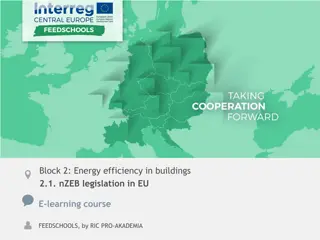Understanding Insulation and Energy Efficiency in Grade 7 Natural Sciences
Exploring the importance of insulation in managing heat transfer, this Grade 7 Natural Sciences topic covers heat transfer mechanisms, energy savings, and solar water heating systems. Learn about warm-blooded organisms' ability to regulate body temperature and how energy efficiency plays a crucial role in everyday life.
Download Presentation

Please find below an Image/Link to download the presentation.
The content on the website is provided AS IS for your information and personal use only. It may not be sold, licensed, or shared on other websites without obtaining consent from the author. Download presentation by click this link. If you encounter any issues during the download, it is possible that the publisher has removed the file from their server.
E N D
Presentation Transcript
Natural Sciences Grade 7 Term 3: Energy and Change Insulation and energy savings
Topic 4 Insulation and Energy Savings Using insulating materials [part 2] Natural Sciences - Grade 7
Insulation, energy saving and energy transfer to the Insulation, energy saving and energy transfer to the surroundings [pictures] surroundings [pictures] Natural Sciences - Grade 7
Insulation, energy saving and energy transfer to the surroundings You have learnt that heat can be transferred by means of three methods: Conduction; Convection and Radiation. In this topic we focused on the importance of insulation in controlling heat loss and gain. Vests and jackets keep us warm. Natural Sciences - Grade 7
Heat transfer Heat transfer Heat energy is transferred from an area of high temperature to an area of low temperature. The transfer of heat can only occur if there is a temperature difference between the two locations. Heat is always transferred from the hotter area or object to the cooler one. Natural Sciences - Grade 7
Fun Facts Fun Facts Warm-blooded organisms such as humans, other mammals and birds have the ability to maintain a constant body temperature. Did you know: Listen Humans have an average body temperature of 36,9 C. The body temperature of birds can be up to 42 C. When the internal body temperature is much higher than the temperature of the surroundings, heat moves from our bodies to the environment. We experience heat loss. Birds are covered with feathers and mammals with fur or wool to cope with this problem. Humans insulate their bodies with coverings such as clothing, jackets and blankets. Natural Sciences - Grade 7
Solar water heating systems Solar water heating systems Energy from the sun can be absorbed and used to heat things, like water. HOW??? Commercial solar collectors that heat water are simple black boxes with tubes of water inside them. The box absorbs radiation from the sun, which heats water in the tubes. The hot water is pumped to a storage tank. More advanced solar water heaters use more effective boxes for gathering solar energy. Natural Sciences - Grade 7
Energy efficiency Energy efficiency means that the maximum amount of heat energy is gained by an area or object with minimal loss of heat energy to the surroundings. In an energy efficient system, the energy gained by an area is far greater than the energy lost by the area. Energy efficiency = Energy input Energy output Natural Sciences - Grade 7
Controlling the rate of heat flow in homes Heat flows from a hotter area to a colder area. Increasing or decreasing the rate at which heat flows between two locations is very important when it comes to insulating houses. During winter we must try to prevent heat escaping from the house to the environment through the walls, ceilings, windows, doors and roof. In summer we must try to prevent heat from entering the house. We can solve these problems by using insulating materials. Natural Sciences - Grade 7























